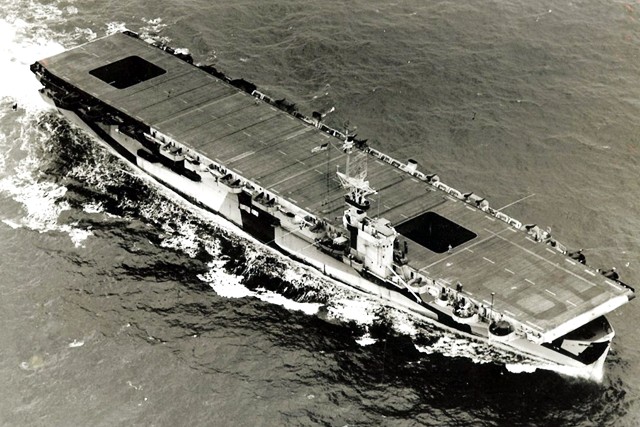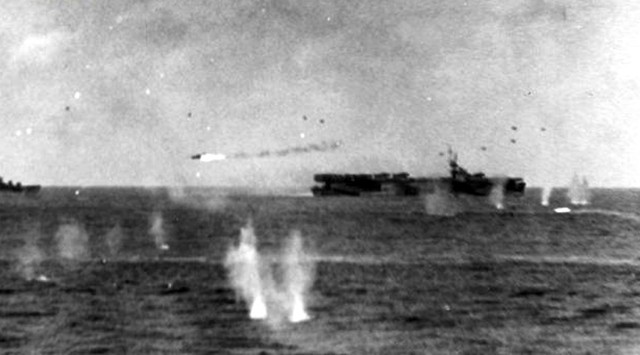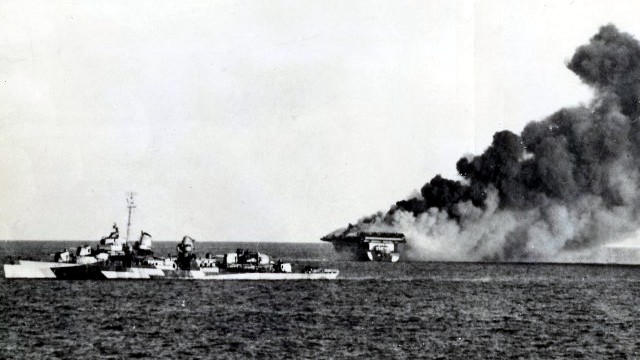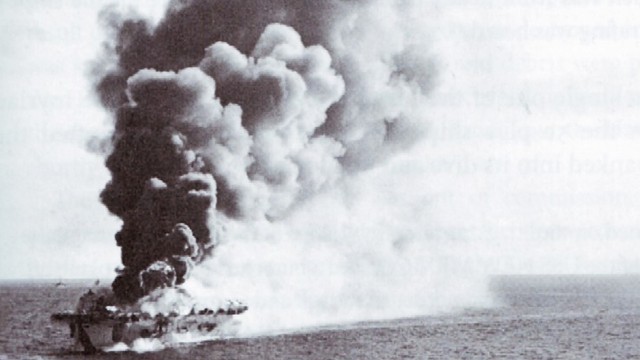January 03, 2012

The USS Ommaney Bay (CVE-79) was the twenty-fifth of the fifty Casablanca-class escort carrier built. Constructed in just over two months by the Kaiser Company shipyard in Vancouver, WA, she weighed in at just over 10000 tons at full load. At full steam, she could move her crew of 860 men and the embarked "composite wing" of 28 planes at 19kts. Like most other escort carriers, she wasn't designed to fight with the fleet. Instead, CVEs were to be used first as stopgaps, then when bigger carriers became available, to free up the more capable CVs and CVLs to hunt for bigger targets. In effect, the CVE became a air support unit, providing air cover for amphibious landings. It was in this role that she was off Leyte as part of Taffy 2 when Admiral Kurita's fleet famously attacked Taffy 3. Ommaney Bay helped sink one of the Japanese cruisers and aided in the defeat of the larger Japanese force. And it was in the air support role that the Ommaney Bay was going to serve as she transited the Sulu Sea.
Then the kamikazes came.

The Ommaney Bay carried eight twin-mounted 40mm Bofors cannon and twenty single-mount 20mm Oerlikon guns for air defense. The other ships in the Sulu Sea with her added their own fire support, and managed to shoot down or drive off a number of the attacking land-based Imperial Japanese Navy airplanes. One Yokosuka P1Y Ginga (Allied reporting name: Frances) dove on the "Big O", releasing two bombs. The plane grazed the island, then cartwheeled into the ship's starboard side. The two bombs, however, caused the real damage. One penetrated all the way through the hangar bay and exploded on the starboard side; this had the effect of ruining the ship's fire mains. One of the reasons the Kaiser shipyards could build CVEs and Liberty Ships so quickly and cheaply was that they cut corners whenever possible. The fire mains were made out of fragile cast iron instead of the steel pipe used in the bigger fleet carriers, and thus more susceptible to damage. This was considered acceptable, for a CVE was never expected to face much in the way of enemy action. The other bomb punched through the flight deck and exploded amongst fueled and armed planes in the forward part of the hangar deck.

Almost immediately, the Ommaney Bay was in serious trouble. With no water pressure available to fight the blazing fires in the hangar bay, no bridge communications and limited-to-no power, the inferno quickly spread. Ammunition in the airplanes began to cook off, driving the firefighting crew from the hangar.

The fires soon ate through the forward flight deck, rendering the whole of the upper surfaces of the ship uninhabitable. Adding to the danger was that in the Casablanca-class of CVE, aerial torpedoes were stored just below the hangar deck, and could explode at any time. Abandon ship was called around 5pm, just a short time after the attack took place. While the escorting destroyers were about to finish the task of taking the crew off, torpedo warheads began to cook off, killing two sailors on one destroyer.
With no hope of saving the blazing Ommaney Bay, the USS Burns launched one torpedo into her side, sending her to the bottom with 93 of her crew. The date was January 4th, 1945, 67 years ago.
Posted by: Wonderduck at
08:37 PM
| Comments (15)
| Add Comment
Post contains 567 words, total size 4 kb.
Posted by: GreyDuck at January 03, 2012 10:35 PM (eHm8o)
Posted by: Wonderduck at January 03, 2012 11:09 PM (f/6aJ)
Posted by: Ben at January 04, 2012 09:11 AM (RalIr)
IIRC Kaiser also had shipyards at Swan Island in the Willamette in Portland. (Which is misnamed because it isn't really an island.)
Posted by: Steven Den Beste at January 04, 2012 10:10 AM (+rSRq)
So the question is, what would a modern CVE look like? Converted merchant ship with a drone payload? Build enough of those and things could get scary...
Posted by: Avatar_exADV at January 04, 2012 11:55 PM (pWQz4)
Posted by: Steven Den Beste at January 05, 2012 12:49 AM (+rSRq)
Posted by: cxt217 at January 05, 2012 06:04 PM (f81z8)
Posted by: Avatar_exADV at January 06, 2012 12:53 AM (GJQTS)
Posted by: Wonderduck at January 06, 2012 08:02 AM (f/6aJ)
Posted by: cxt217 at January 06, 2012 03:57 PM (f81z8)
Until it took two Exocets into its merchy hull, that is.
Posted by: Wonderduck at January 06, 2012 06:21 PM (f/6aJ)
Posted by: Avatar_exADV at January 06, 2012 08:31 PM (pWQz4)
I think the Atlantic Conveyor is actually closer to a MAC than a CVE.
Posted by: brickmuppet at January 06, 2012 09:20 PM (EJaOX)
Posted by: Jerry Grass at June 13, 2012 07:36 PM (OC5ri)
Posted by: Wonderduck at June 13, 2012 08:22 PM (V/OLv)
46 queries taking 0.2016 seconds, 176 records returned.
Powered by Minx 1.1.6c-pink.









